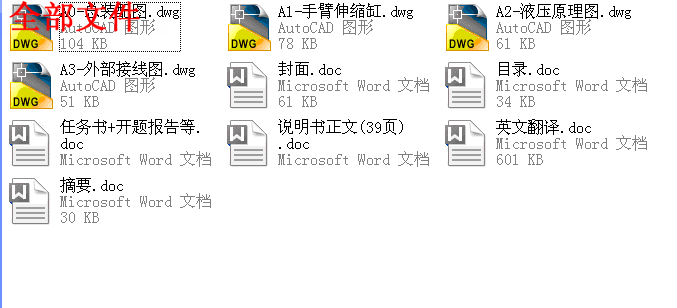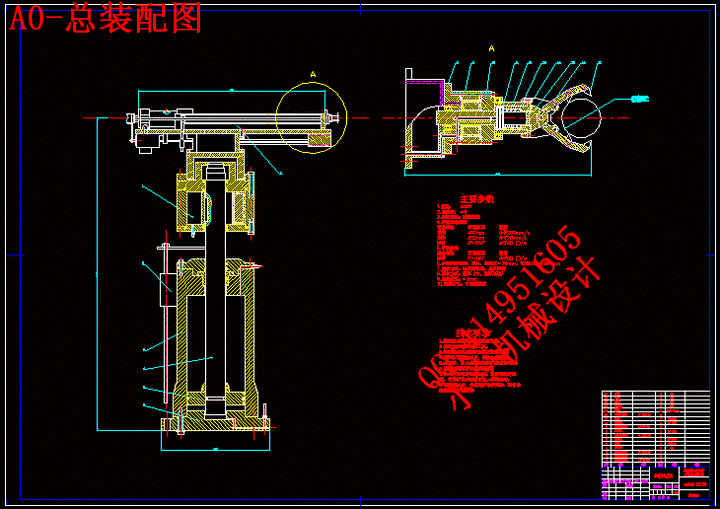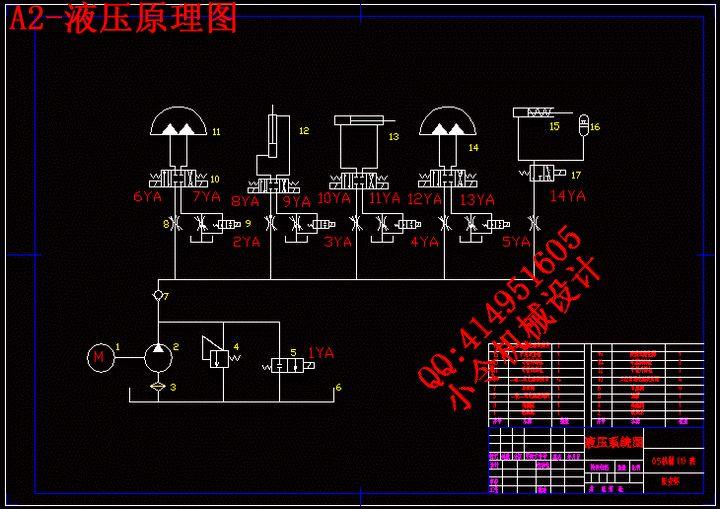【温馨提示】 购买原稿文件请充值后自助下载。
[全部文件] 那张截图中的文件为本资料所有内容,下载后即可获得。
预览截图请勿抄袭,原稿文件完整清晰,无水印,可编辑。
有疑问可以咨询QQ:414951605或1304139763
摘 要
本文设计的关节型机械手采用圆柱坐标式,能完成上料、翻转等功能。此机械手主要由手爪、手腕、手臂和机身等部分组成,具有手腕回转、手臂伸缩、手臂升降和手臂回转4个自由度,能够满足一般的工业要求。
该机械手由电位器定位,实行点位控制,控制系统采用PLC可编程控制,具有良好的通用性和灵活性。
该机械手为液压驱动,4个自由度和手爪的夹紧都由液压缸驱动,在油路的布置和规划中结合机械制造的基础,不断使油路符合制造的可行性,而且将油路布置成空间结构,使机械手的结构更加简洁和紧凑。
关键字:关节型机械手 圆柱坐标 液压缸 可编程控制
Abstract
In this paper, the design of the joint-type robot using cylindrical coordinates of type, can be completed on the expected, inversion and other functions. Mainly by the manipulator hand, wrist, arm and body parts, etc., with rotating wrists, arms stretching, arm movements and arm rotation four degrees of freedom, able to meet the general requirements of the industry.
The manipulator by the potentiometer position, the implementation of the control points, the control system using PLC programmable control, has a good generality and flexibility.
The manipulator for the hydraulic-driven, four degrees of freedom and the clamping gripper driven by the hydraulic cylinder in the circuit layout and planning based on the combination of machinery manufacturing, and continuously so that the feasibility of manufacturing in line with the circuit, but also circuit layout into a spatial structure, so that the structure of manipulator more concise and compact.
Keywords: joint-type robot cylindrical coordinates hydraulic cylinders PLC.
目 录
摘要 …………………………………………………………………………………i
Abstract ……………………………………………………………………………ii
1 绪论 ……………………………………………………………………… 1
1.1 研究目的及意义 ………………………………………………………… 1
1.2 本课题研究内容 ………………………………………………………… 2
2 机械手的总体设计 ……………………………………………………… 3
2.1 工业机械手的组成 ……………………………………………………… 3
2.1.1 执行机构 ………………………………………………………… 3
2.1.2 驱动机构 ……………………………………………………………4
2.1.3 控制系统 ………………………………………………………… 4
2.2 关节型机械手的主要技术参数 ………………………………………… 4
2.3 圆柱坐标式机械手运动简图………………………………………………5
3 关节型机械手机械系统设计 ……………………………………………6
3.1 手部 ………………………………………………………………………6
3.1.1 夹紧力的计算 ……………………………………………………6
3.1.2 夹紧缸驱动力计算 ………………………………………………7
3.1.3 两支点回转型手指的夹持误差分析与计算 ……………………8
3.1.4 夹紧缸的计算 ……………………………………………………10
3.2 腕部 ………………………………………………………………………11
3.2.1 腕部设计的基本要求 ……………………………………………11
3.2.2 腕部回转力矩的计算 ……………………………………………12
3.2.3 手腕回转缸的设计计算 …………………………………………14
3.3 臂部 ………………………………………………………………………15
3.3.1 手臂伸缩液压缸 …………………………………………………15
3.3.2 手臂回转液压缸 …………………………………………………23
4 机械手的液压驱动系统 …………………………………………………27
4.1 程序控制机械手的液压系统 ……………………………………………27
4.2 液压系统 …………………………………………………………………27
4.2.1 各液压缸的换压回路 ……………………………………………27
4.2.2 调速方案 …………………………………………………………28
4.2.3 减速缓冲回路 ……………………………………………………29
4.3 液压系统的合成 …………………………………………………………29
5 机械手的可编程控制 ……………………………………………………31
5.1 输入输出触点的分配 ……………………………………………………31
5.1.1 行程开关的分配 …………………………………………………31
5.1.2 手动按钮的分配 …………………………………………………31
5.1.3 输入输出继电器的分配 …………………………………………32
5.2 外部接线图 ………………………………………………………………32
5.3 控制面板设计 ……………………………………………………………33
5.4 状态控制图 ………………………………………………………………34
5.5 梯形图 ……………………………………………………………………35
结论 …………………………………………………………………………………37
致谢 …………………………………………………………………………………38
参考文献 ……………………………………………………………………………39
1 绪论
机械手是近几十年发展起来的一种高科技自动化生产设备。它的特点是可通过编程来完成各种预期的作业任务,在构造和性能上兼有人和机器各自的优点,尤其体现了人的智能和适应性。机械手作业的准确性和各种环境中完成作业的能力,在国民经济各领域有着广阔的发展前景。
1.1 研究目的及意义
工业机械手具有许多人类无法比拟的优点,满足了社会化大生产的需要,其主要优点如下:
1.能代替人从事危险、有害的操作。只要根据工作环境进行合理设计,选择适当的材料和结构,机械手就可以在异常高温或低温、异常压力和有害气体、粉尘、放射线作用下,以及冲压、灭火等危险环境中胜任工作。工伤事故多的工种,如冲压、压铸、热处理、锻造、喷漆以及有强烈紫外线照射的电弧焊等作业中,应推广工业机械手或机器人。
2.能长时间工作,不怕疲劳,可以把人从繁重单调的劳动中解放出来,并能扩大和延伸人的功能。人在连续工作几小时后,总会感到疲劳或厌倦,而机械手只要注意维护、检修,即能胜任长时间的单调重复劳动。
3.动作准确,因此可以稳定和提高产品的质量,同时又可避免人为的操作错误。
4.机械手特别是通用工业机械手的通用性、灵活性好,能较好地适应产品品种的不断变化,以满足柔性生产的需要。
5.机械手能明显地提高劳动生产率和降低成本。
由于机械手在工业自动化和信息化中发挥了以上巨大的作用,世界各国都很重视工业机械手的应用和发展,机械手的应用在我过还属于起步阶段,就显示出了许多的无法替代的优点,展现了广阔的应用前景。近十几年来,机械手的开发不仅越来越优化,而且涵盖了许多领域,应用的范畴十分广阔。
1.2 本课题研究内容
要求本设计能较鲜明地体现机电一体化的设计构思。所谓机电一体化,是机械工程技术吸收微电子技术、信息处理技术、传感技术等而形成的一种新的综合集成技术。尽管机电一体化的产品名目繁多,并由于它们的功能不同而有不同的形式和复杂程度,但做功的机械本体部分(包括动力装置)和微点自控制部分(包括信息处理)是最基本的、必不可少的要素。
本设计要求完成以下工作:
拟定整体方案,特别是控制方式与机械本体的有机结合的设计方案。
根据给定的自由度和技术参数选择合适的手部、腕部和臂部的结构。
各部件的设计计算。
机械手工作装配图的设计与绘制。
液压系统图的设计与绘制。
编写设计计算说明书。
2 机械手的总体设计
2.1 工业机械手的组成
工业机械手是由执行机构、驱动系统和控制系统所组成的,各部关系
2.1.1 执行机构
1.手部 即直接与工件接触的部分,一般是回转型或平移型(为回转型,因其结构简单)。手爪多为两指(也有多指);根据需要分为外抓式和内抓式两种;也可用负压式或真空式的空气吸盘(它主要用于吸取冷的,光滑表面的零件或薄板零件)和电磁吸盘。
传力机构型式较多,常用的有:滑槽杠杆式、连杆杠杆式、斜楔杠杆式、轮齿条式、丝杠螺母式、弹簧式和重力式。
2.腕部 是连接手部和手臂的部件,并可用来调整被抓物体的方位(即姿态)。它可以有上下摆动,左右摆动和绕自身轴线的回转三个运动。如有特殊要求(将轴类零件放在顶尖上,将筒类、盘类零件卡在卡盘上等),手腕还可以有一个小距离的横移。也有的工业机械手没有腕部自由度。
3.臂部 手臂是支承被抓物、手部、腕部的重要部件。手部的作用是带动手指去抓取物体,并按预定要求将其搬到预定的位置。手臂有三个自由度,可采用直角坐标(前后、上下、左右都是直线),圆柱坐标(前后、上下直线往复运动和左右旋转),球坐标(前后伸缩、上下摆动和左右旋转)和多关节(手臂能任意伸屈)四种方式。
直角坐标占空间大,工作范围小,惯性大,其优点是结构简单、刚度高,在自由度较少时使用。圆柱坐标占空间较小,工作范围较大,但惯性也大,且不能抓取底面物体。球坐标式和多关节式占用空间小,工作范围大,惯性小,所需动力小,能抓取底面物体,多关节还可以绕障碍物选择途径,但多关节式结构复杂,所以也不常用。
2.1.2 驱动机构
有气动、液动、电动和机械式四种形式。气动式速度快,结构简单,成本低。采用点位控制或机械挡块定位时,有较高的重复定位精度,但臂力一般在300N以下。液动式的出力大,臂力可达 1000N 以上,且可用电液伺服机构,可实现连续控制,使工业机械手的用途和通用性更广,定位精度一般在 1mm 范围内。目前常用的是气动和液动驱动方式。电动式用于小型,机械式只用于动作简单的场合。
2.1.3 控制系统
有点动控制和连续控制两种方式。大多数用插销板进行点位程序控制,也有采用可编程序控制器控制、微型计算机数字控制,采用凸轮、磁带磁盘、穿孔卡等记录程序。主要控制的是坐标位置,并注意其加速度特征。
2.2 关节型机械手的主要技术参数
1.抓重: 300N
2.自由度: 4个
3.坐标形式:圆柱坐标
4.手臂运动参数
运动名称 符号 行程范围 速度
伸缩 X 400mm 小于250mm/s
升 降 Z 300mm 小于70mm/s
回转 ψ 0°~210° 小于90 (°)/s
5.手腕参数
运动名称 符号 行程范围 速度
回转 ω 0°~180° 小于90 (°)/s
6.手指夹持范围:棒料,直径50~70mm,长度450~1200mm
7.定位方式:电位器设定,点位控制
8.驱动方式:液压(中、低压系统)
9.定位精度:±3mm
10.控制方式:可编程控制
2.3 圆柱坐标式机械手运动简图
经过考虑,本设计的机械手设计成如下简图形式:
3 关节型机械手机械系统设计
3.1 手部
手部(亦称抓取机构)是用来直接握持工件的部件,由于被握持工件的形状、尺寸大小、重量、材料性能、表面状况等的不同,所以工业机械手的手部结构多种多样,大部分的手部结构是根据特定的工件要求而定的。归结起来,常用的手部,按其握持工件的原理,大致可分成夹持和吸附两大类。
根据设计要求,这里只讨论夹钳式的手部结构。
夹钳式手部是由手指、传动机构和驱动装置三部分组成的,它对抓取各种形状的工件具有较大的适应性,可以抓取轴、盘、套类零件。一般情况下,多采用两个手指。驱动装置为传动机构提供动力,驱动源有液压的、气动的和电动的等几种形式。常见的传动机构往往通过滑槽、斜楔、齿轮齿条、连杆机构实现夹紧或放松。
平移型手指的张开闭合靠手指的平行移动,适于夹持平板、方料。在夹持直径不同的圆棒时,不会引起中心位置的偏移。但这种手指结构比较复杂、体积大,要求加工精度高。根据设计要求,工件是圆盘,所以采用回转型手指,其张开和闭合靠手指根部(以枢轴支点为中心)的回转运动来完成。枢轴支点为一个的,称为单支点回转型;为两个支点的,称为双支点回转型。这种手指结构简单,形状小巧,但夹持不同工件会产生夹持定位误差。
本设计要求抓取棒料,故采用夹钳式手部。







 川公网安备: 51019002004831号
川公网安备: 51019002004831号